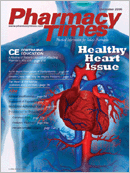Publication
Article
Pharmacy Times
Severe Chest Pain May Be Angina Pectoris
Author(s):
Angina pectoris is characterizedby severe chest pain, pressure,or tightness. It affects, to somedegree, ~6.5 million individuals in theUnited States.1 The fundamental cause ofangina pectoris is an imbalance betweenthe oxygen requirement of the heart andthe oxygen supplied to the heart by wayof the coronary vessels.2 Angina is also asymptom of ischemic heart.
Symptoms Associated with Angina
Although pain and discomfort are theclassic symptoms related to anginaattacks, patients should be alerted toother signs and symptoms that may beassociated with angina. Episodes of painor discomfort typically start under thebreastbone but may radiate to other areassuch as the arms, left shoulder, back,neck, jaw, or stomach. Patients also mayexperience other symptoms, such as1,3 :
- Episodes of difficulty in breathing orshortness of breath
- Sweating, light-headedness, dizziness,extreme weakness, or anxiety
- Feeling of indigestion
- Nausea or vomiting
- Rapid or irregular heartbeats
Types of Angina
There are 3 types of angina: stable,unstable, and variant (also referred to asPrinzmetal's angina; Table 14). Each year,there are ~400,000 new cases of stableangina.3,5 An estimated 1 million patientsare hospitalized each year with a primarydiagnosis of unstable angina.6 Variant(Prinzmetal's) angina is rare and accountsfor only 2 of every 100 cases of angina; itis caused by a coronary spasm.4
Diagnosing Angina
To determine whether an individualhas angina, the primary health careprovider can perform many types oftests. Examples of what the physicianmay do are as follows:
- Perform a physical examination thatmay include laboratory tests, anelectrocardiogram, and stress tests
- Evaluate the types and severity ofthe symptoms
- Determine whether the individualhas risk factors associated with thedevelopment of coronary artery disease(Table 21)
Treatment
In treating angina, various strategiesmay be used to effectively and safelymanage the condition, depending on theseverity of the symptoms. These treatmentplans can include lifestyle modifications,the use of pharmacologic agents,cardiac procedures, and cardiac rehabilitation.The goals of treating angina are tosuccessfully control the condition byreducing both the frequency and theseverity of angina symptoms, as wellas possibly preventing further complications.
The use of pharmacologic agents inconjunction with lifestyle modificationsmay improve an individual's quality oflife. The cardiovascular agents commonlyused to treat angina include nitrates, ?-blockers, and calcium channel blockers.
In February 2006, the FDA approvedRanexa (ranolazine), manufactured by CVTherapeutics, for the treatment of chronicangina. It is the first new drugapproved to treat chronic angina in morethan a decade. Because Ranexa prolongsthe QT interval, it should be reserved forthose individuals who have not respondedto other antianginal medications.
Ranexa should be used in conjunctionwith amlodipine, ?-blockers, or nitrates.Ranexa is contraindicated in individualswith preexisting QT prolongation, inthose with hepatic impairment, and inindividuals taking drugs that prolong theQTc interval. The drug also is contraindicatedin those individuals receivingpotent and moderately potent CYP3Ainhibitors, including diltiazem.7
Initially, Ranexa is dosed at 500 mg bid,and it may be increased to 1000 mg bidas needed, based on clinical symptoms.The maximum recommended daily doseis 1000 mg bid. Common adverse effectsinclude dizziness, headache, constipation,and nausea.
In addition, angiotensin-convertingenzyme inhibitors, antiplatelet drugs, andantihyperlipidemic agents, as well asanticoagulants, often are used in thispatient population, depending on thepatient's specific needs. Pharmacists arein a key position to monitor potentialdrug interactions as well as possible contraindications.
When a patient does not respond tomedication, various invasive proceduressuch as angioplasty and coronary arterybypass surgery may be performed.
Ms. Terrie is a clinical pharmacywriter based in Haymarket,Va.
For a list of references, send a stamped,self-addressed envelope to: ReferencesDepartment, Attn. A. Rybovic, PharmacyTimes, Ascend Media Healthcare, 103 CollegeRoad East, Princeton, NJ 08540; or send ane-mail request to: arybovic@ascendmedia.com.







